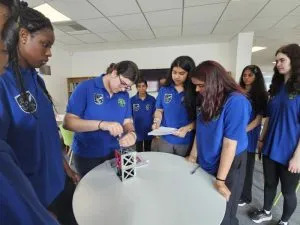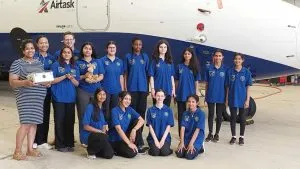The school – Croydon High School – successfully completed the final stage of live testing their CubeSat satellite for Mission Pegasus.
The initiative, encouraging STEM participation, involves the all-girl Astrogazers club. And their prototype CubeSat satellite was carried aboard the FAAM Airborne Laboratory aircraft last week. This is a highly modified BAe-146 aircraft used for atmospheric research.
Astrogazers
“This flight test is a major milestone in Astrogazers’ ambition to reach space,” said Professor Cathryn Mitchell, from the University of Bath’s Department of Electronic & Electrical Engineering. What seemed incredible is now becoming a reality.
“If they have done everything perfectly, which I believe they have as I’ve seen how rigorously they work, then they will record the data and bring it back to analyse as they would if it was coming back from a real spacecraft mission.”
Testing
 During the test the prototype satellite gathered data successfully to prove the payload. It measures air quality in the atmosphere.
During the test the prototype satellite gathered data successfully to prove the payload. It measures air quality in the atmosphere.
This data, alongside measurements taken at ground level from the school roof and from the FAAM aircraft itself, is now being analysed.
The Astrogazers plan to launch their CubeSat in 2026-27.
“The Astrogazers team haven’t just learned about space technology – they’ve built it,” added Dr Robert Watson, also from from the Department of Electronic & Electrical Engineering.
“From science to software engineering, to electronics and carrying out assembly, integration and test, they’ve once again demonstrated that with curiosity, creativity and teamwork, complex engineering is not only accessible – it’s theirs to lead.”
Royal Astronomical Society
The Astrogazers Club was founded by Mrs Arabi Karteepan, Head of Physics at Croydon High School. And it won the prestigious Royal Astronomical Society’s Secondary and Further Education Award in 2024.
“When one of my pupils asked me ‘can we go to space?’, naturally I said yes,” said Karteepan.
“Our students have built a working satellite instrument and have now tested it under genuine flight conditions. Part of their success is due to the fact that they operate with all the professionalism of a real space company. This is real science, performed at the highest level.”
Note that the project has also been part funded by the Royal Society and the University of Bath Alumni Fund. It was also supported by Spirent Communications, FAAM, Cranfield Airport, Surrey Space Centre, and Mullard Space Science Laboratory.
Weather balloons
Two years ago, in September 2023, the same club completed ‘Mission Aspiration’ launches. Again, this was with help from the University of Bath and Professor Cathryn Mitchell.
They become the first UK school to launch, and retrieve, two experimental high-altitude weather balloons reaching the edge of space.
The two meteorological balloons were launched from the University of Bath campus last month, with both reaching an altitude of more than 32,000 metres – well into Earth’s stratosphere.
Images: Croydon High School
See also: AmbaSat showcases AmbaSat 3U CubeSat at regional space conference

